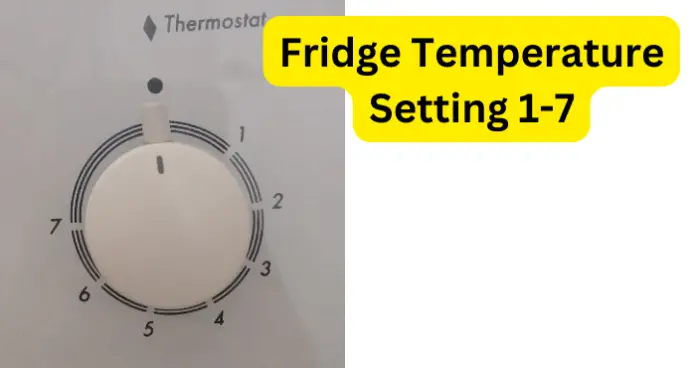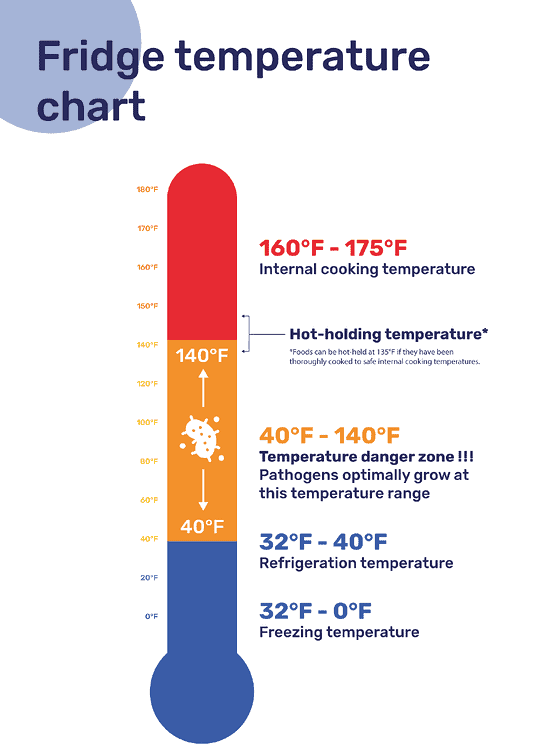
Have you ever looked at the temperature dial on your fridge and wondered, what do those numbers mean and better yet, which one is the best for what I am storing in your fridge?
Well, you are not alone, as many people have been curious about what the temperature settings for their fridges mean and which setting they should have it set at.
Fridge Temperature Chart

It may not be something that regularly comes to mind; however, the temperature that your fridge is operating at plays an important role in how safe your foods are. Not only foods but also liquids such as milk, yogurts, and juices.
The only way to keep most foods fresh is to keep them at a cool temperature but also not quite at the freezing point either. With this in mind, you will want to keep your refrigerator in the range of 35° -38° Fahrenheit (or 1.7° -3.3° Celsius).
Now, this is certainly not as cold as absolute zero; however, it is still cold enough for some of your foods to freeze. Ideally, you want your refrigerator temperature to sit at an even 37 degrees Fahrenheit.
If you would like to keep track of the exact temperature of your fridge, you can purchase a fridge thermometer (view on Amazon). You can also find a thermometer at your local home store or hardware store.
This way you know the exact temperature inside your refrigerator. With that said, some fridges do come with a built-in thermometer and you can refer to that (if you have one). As far as your freezer goes, you will want it to remain at around zero degrees.
Remember, if you do use a thermometer to track the temperature inside your fridge, after placing the thermometer inside, you should give it at least 20 minutes before checking the temperature.
It is very important to know the temperature of your refrigerator since it is what determines how fresh your stored foods will remain. If your fridge came with a built-in thermometer you are in luck, since you can easily keep track of the temperature within your fridge by using the thermometer.
If you do not have a fridge with a built-in thermometer, it is advised that you get one so that you can have an accurate reading of the temperature of your refrigerator.
This especially applies if you love having raw meats at hand, if you are not freezing and thawing your raw meats, you will want to know that you are maintaining a safe temperature for your meats.
This is because raw meats are especially susceptible to bacteria, do not take your chances with raw meats. Do yourself a healthy favor and get a thermometer, so that you know that you are maintaining a healthy temperature inside your fridge.
The same could be said for vegetables such as lettuce, tomatoes, carrots ect. If vegetables get too warm they can gather bacteria, which can make you very sick.
Most of your fruits and vegetables can be stored in your fridge, so long as you keep the refrigerator at average temperatures of 35 to 40 degrees Fahrenheit; however, some fruits and vegetables such as bananas, squash, tomatoes, and lemons should be kept at temperatures lower than 50 degrees.
Refrigerator Temperatures Explained
The numbers on the dial inside of your fridge essentially stand for the temperature settings for the refrigerator. Whereas the one setting number is the warmest setting, which is because when you set the fridge at 1, the refrigerator is running at its warmest temperature setting aside from the “Off” setting.
Typically with most commercial refrigerators, when you set the dial setting to “Off,” the temperature for the fridge will be set to “1” and the compressor will be set to “7.” You can view the temperature settings 1-4 as essentially adjustment settings ranges.
The number “4” temperature setting is the optimal preference adjustment setting, which means if you just purchased the fridge, you will want to set it to “4,” then close the doors of the fridge and allow it to sit for at least 20 minutes.
After the fridge has been sitting at this temp setting for an appropriate amount of time, you can adjust it to your preferences. Keep in mind, with the temperature setting numbers, the higher the number the colder it will be inside of the refrigerator.
With this information in mind, whereas the “1” temp setting is the warmest setting possible by the refrigerator system, the number “7” setting will be the coldest temp setting.
Also, bear in mind that if you just purchased the refrigerator, most manufacturers will set the fridge to about mid-way, which is typically about 4 or 5. After that, it is up to you to set the fridge to the temp setting that you would like.
Remember, that the best temperature setting to keep foods fresh for as long as possible is approximately 37 degrees Fahrenheit to 40 degrees, anything above 40 degrees is not suitable for storing foods and drinks.
Fridge Numbers to Degrees
As previously mentioned, the temperature setting numbers for a refrigerator dictate the temperature setting for the inside of the fridge.
So, the number “1” setting for your fridge is the very minimal amount of cooling that the refrigerator can provide, and the number “7” setting is the absolute coldest temperature setting for the fridge.
Let’s give this some perspective. For example, for all seasons around an acceptable temperature setting would typically be the “5” setting, you should remember from earlier that this is the “average” temp setting for the refrigerator, and is the setting the fridge is at when you have just purchased or received it.
Whereas in the summertime, you should kick that dial up to at least the “6” or “7” temperature setting.
With the fridge temperature setting at the “7” option, it is set to the coldest setting the fridge can reach, which is what you want on those toasty summer days.
This ensures that the fridge remains at an acceptable temp even if you may have children who regularly open the fridge door(s). Overall, the temperature setting that is the “best” is likely the “5” setting, which typically ensures that the inside of the refrigerator stays at an optimal 37 degrees Fahrenheit.
So, if you like your milk to be slightly frozen, you can keep the fridge temp setting on the “7,” as this is the coldest setting the refrigerator can reach.
Lowest Temperature Setting 1-3
The temperature range between “1” and “3” on your fridge is the very minimal amount of cooling that the appliance can offer.
There is no reason or sensibility in setting your fridge to this temp setting unless you are storing flowers or something to that effect in the refrigerator.
Keep in mind, that the “average” temperature setting for a refrigerator is the “5” setting, which means that anything lower than the “5” temp setting is considered unsafe for food storage temperatures.
If you by chance, live in the Artic and have your fridge outside, you might get by with the lower “1-3” temperature settings.
Mid or Average Temperature Setting 4-6
If you just purchased or ordered a refrigerator and have received it, you will likely notice that it is set to the “5” temperature setting.
This is because this is considered the “average” temp setting for a fridge, this is also known as the “adjustable” temp setting since you can set your fridge to the “5” temp setting and let it rest with the doors closed for about 20 minutes; then you can adjust the temperature from there to your preference.
This is why manufacturers will typically set it to the “5” setting as an average refrigerator temp setting so that you can personalize the cool setting for your refrigerator.
Coldest Temperature Setting – 7
This refrigerator temperature setting is for all of you out there that like it cold. The “7” temp setting on your fridge is the coldest possible setting, which means that if you like your foods to stay chilly, you can set your fridge to the “7” temp setting.
This temperature setting is also acceptable for if you live in an area that is exceptionally warm year round, it is also suitable for summertime since the outside temperatures are typically higher than any other season.
The “7” temperature setting on your fridge is also suitable for storing raw meats that you intend to cook soon.
Since the “7” temperature setting on most fridges sits in the range of 35 degrees Celsius it makes this refrigerator temp setting ideal for keeping your foods fresh in the summertime.
Also, keep in mind that the higher the power that is being drawn by the fridge, the higher your electricity bill will be. Though this is not always the case, since most modern refrigerators are quite an energy efficient.
Typically in most refrigerators, the temperature for the door shelves will sit around 4 degrees Celsius at the top of the shelves and 3 degrees celsius at the bottom shelves. This is why the door shelves are mainly used for condiments, soft drinks, and butter.
Refrigerators are incredible appliances when you stop to think about it; however, it can be difficult figuring out the right temperature setting for you, your household, and how much food you have stored in your fridge.
That is why it is good to familiarize yourself with what the temp settings on a refrigerator are and what they mean, and luckily, with this guide, you will be able to narrow down an optimal setting for your fridge.
We can take some luxuries for granted such as our refrigerators, so be sure to pat your fridge every once in a while and let it know it is a good fridge.
Remember, when dealing with fridge temperature settings that you are not only determining how cool your refrigerator will stay, but you are also making a potential health decision.
If there is anything you should take away from this feature is that you want your fridge to maintain an average temp of 35 degrees Fahrenheit, so not only does your food stay fresh for as long as possible but you and your friends or family stay healthy and happy.

Changing the setting because the room temperature changes is incorrect. Each setting will keep the temperature of the refrigerator constant regardless of the room temperature. The setting controls a thermostat. Choose a temperature a little higher than the point where lettuce or water freezes. Lower settings mean less work for the refrigerator and higher temperatures.